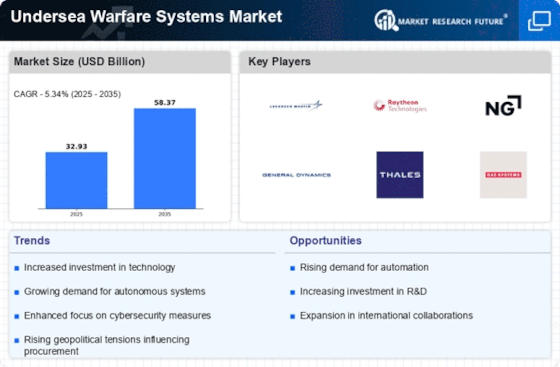Technological Innovations
Technological advancements play a pivotal role in shaping the Undersea Warfare Systems Market. Innovations in sonar systems, autonomous underwater vehicles, and advanced weaponry are transforming naval warfare. For instance, the integration of artificial intelligence in underwater systems enhances operational efficiency and decision-making processes. The market for underwater drones is expected to grow at a compound annual growth rate of 7% through 2026, driven by these technological innovations. As militaries adopt cutting-edge technologies, the demand for sophisticated undersea warfare systems is likely to increase, further propelling the market forward.
Increased Naval Investments
The Undersea Warfare Systems Market is witnessing a significant increase in naval investments from various countries. Governments are recognizing the strategic importance of maintaining a robust underwater presence, leading to enhanced funding for research and development in undersea warfare technologies. In 2025, it is estimated that defense spending on naval capabilities will account for over 30% of total military budgets in several nations. This trend suggests a long-term commitment to strengthening undersea warfare capabilities, which is expected to stimulate growth in the Undersea Warfare Systems Market as new systems and technologies are developed and deployed.
Rising Geopolitical Tensions
The Undersea Warfare Systems Market is experiencing a notable surge due to escalating geopolitical tensions among nations. As countries seek to enhance their naval capabilities, investments in undersea warfare technologies are increasing. The need for advanced submarines, unmanned underwater vehicles, and anti-submarine warfare systems is becoming more pronounced. In 2025, military budgets allocated for naval defense are projected to rise by approximately 5%, reflecting a strategic shift towards undersea capabilities. This trend indicates that nations are prioritizing their underwater defense strategies to counter potential threats, thereby driving growth in the Undersea Warfare Systems Market.
Emerging Threats and Asymmetric Warfare
The Undersea Warfare Systems Market is being shaped by the emergence of new threats and asymmetric warfare strategies. Non-state actors and rogue nations are increasingly utilizing unconventional tactics, necessitating advanced undersea capabilities to counter these threats. The demand for systems that can detect and neutralize underwater threats is on the rise. In 2025, it is projected that investments in countermeasures against underwater mines and stealthy submarines will increase significantly. This evolving threat landscape is likely to drive innovation and investment in the Undersea Warfare Systems Market, as nations seek to enhance their defensive and offensive capabilities.
Environmental Awareness and Regulations
Environmental considerations are increasingly influencing the Undersea Warfare Systems Market. As nations become more aware of the ecological impact of military operations, there is a growing emphasis on developing environmentally friendly undersea technologies. Regulations aimed at minimizing the environmental footprint of naval activities are being implemented, prompting manufacturers to innovate sustainable solutions. This shift may lead to the creation of new products that align with environmental standards, thereby expanding the market. The Undersea Warfare Systems Market is likely to adapt to these changes, ensuring compliance while meeting operational requirements.


















Leave a Comment